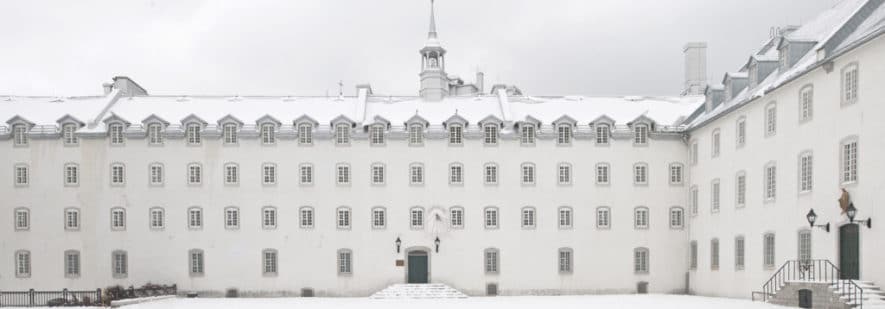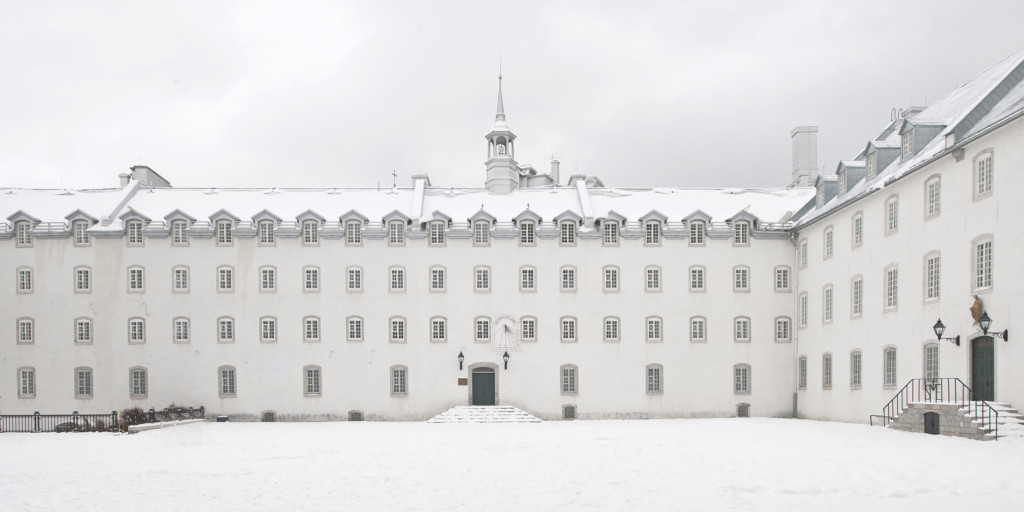Archiscape Blog

Traveling Architect: Quebec City

Inner Courtyard of the Seminaire de Quebec. All photos, Angelo Accomando
‘Here was a small bit of mediaeval Europe perched upon a rock, and dried for keeping, in this north-east corner of America, a curiosity that has not its equal, in its kind, on this side of the ocean … We rode about as if we were in a picture-book, taming over a new leaf at each street!‘… (Henry Ward Beecher).
Indeed, Quebec City, located where the mighty Saint-Lawrence River narrows, midway between the Atlantic Ocean and the Great Lakes, is at first glance frozen in time. Founded by Samuel de Champlain as a French settlement in 1608, on an abandoned Iroquois settlement named Stadacona, Old Quebec has grown from a small French settlement, the capital of New France, to today’s thriving provincial capital. Yet it still feels as it would have in the 19th century.
BASSE VILLE
The city began in the Basse Ville (Lower Town) between the river and the steep cliff of Cap Diamant. Early settlers built warehouses, shops and houses around the port.
French builders and craftsmen brought with them the building techniques and styles from the old country. Rubble walls, mansard roofs, small casement windows are some of these early elements. Basements were of brick. Some of these groin-vaulted and barrel-vaulted spaces are still visible in the lower levels of stores and restaurants.
The oldest surviving areas have narrow, winding streets, while the later area has larger streets made for horses and carriages to cart goods. Nowadays, many buildings have been converted for retail or hotels on the ground floor, and offices or apartments above.
PLACE ROYALE
This square was the center of the young French colony’s life. Merchants built their stores, and a public market was held here until the first half of the 19th century. The church of Notre-Dame-des-Victoires was built in 1635. A bust of Louis XIV was brought here in 1686, and the square was renamed the Place Royale, to honor the king. Here, you can see steep metal roofs, good for keeping snow away. Buildings are attached, chimneys at each end. The stone rubble walls were sometimes plastered, sometimes left exposed.
HAUTE VILLE
One hundred years later, religious institutions (the Séminaire de Québec and others) and government buildings were built on the top of Cap Diamant. Here, larger residences, some in the Château style, were also built. After the Battle on the Plains of Abraham (1759), the British victors set to work fortifying the city. The city’s ramparts are the only remaining fortified city walls in North America. The British brought with them their building traditions, adding to the fabric of the city.
Today, the eclectic mix of styles is a reflection of the rich history of the city. Now designated a World Heritage Site by UNESCO, the city’s architecture is protected and will be enjoyed by generations.
“Le véritable voyage de découverte ne consiste pas à chercher de nouveaux paysages, mais à avoir de nouveaux yeux.”
(“The real voyage of discovery consists not in seeking new landscapes, but in having new eyes.”)
-Marcel Proust, French Novelist & Author 1871-1922
A bientôt,
Karin




